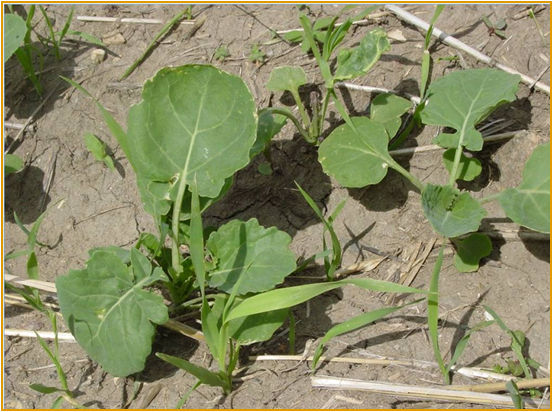5 MIN READ
Managing Volunteer Canola in Soybeans
March 31, 2025
Introduction
- Volunteer canola can be a troublesome weed in soybean, as research has found that volunteer canola populations greater than two plants/square meter in 30-inch rows and 2.7 plants/square meter in 7.5-inch row soybean can reduce soybean yield potential.1
- Management practices are important to reduce the canola seed bank left behind when soybean is grown after canola. Managing volunteer canola in rotation requires intervention at several stages, beginning with management during canola harvest and fall tillage.
- Management continues with rotational crop selection, use of cultural practices that strengthen crop competitiveness with volunteer canola, and application of pre-plant burndown, residual, and in-crop herbicides.
Reduce Harvest Losses
Managing harvest seed losses is likely the most important step in lowering volunteer canola populations, as the average seed loss at harvest ranges from about nine to 220 lb canola seed/acre.2 As most canola is swathed and not combined standing, swathing at the optimum time at 60% of seed color change from green to light tan on the main stem will minimize shattering and harvest loss.2,3 Adjusting the height of the swather to leave about 10 to 12 inches (25 to 30 cm) of stubble helps anchor the windrow, allows adequate air circulation, and harvests the majority of the seed pods.3
Straight combining varieties without good pod shatter tolerance can lead to shattering at preharvest and while gathering pods into combines. These losses can range from 8 to 54%.4 Spring canola is ready to harvest when seed moisture is below 10% and, if combined at this time, should reduce harvest losses.2 A pre-harvest desiccant—such as diquat—may help condition the crop for harvest, particularly in fields with uneven maturity.2
Tillage Management
Most volunteer canola plants emerge the following year and as such the seedbank can be depleted after two years.1,5 The timing of tillage is considered more important than the tillage type. No tillage, or timely tillage after harvest, can promote spring canola germination and reduce seed survival during the winter. Shallow tillage can keep spring canola seed close to the soil surface and can increase the seeds’ susceptibility to winter conditions. A low-disturbance tillage pass can effectively encourage early fall and spring emergence of volunteer canola.
Crop Rotation
Rotating to corn or small grains after spring canola can provide greater crop competition and allow for the use of a range of herbicide sites of action to control volunteer canola. Auxin mimics (Group 4), ALS inhibitor (Group 2), PPO inhibitor (Group 14), and HPPD inhibitor (Group 27) herbicides are recommended by North Dakota State University for volunteer canola control in several crops. Consult the current year’s North Dakota State Weed Control Guide for herbicide effectiveness ratings and control options.6 Consult individual product labels for use instructions, restrictions, and crop planting intervals for your local area.
Cultural Practices
Enhancing the competitiveness of soybean and other crops with spring canola can help reduce the risk of potential yield loss. Volunteer canola does not compete well with vigorously growing crops. Living mulches and inter-row tillage in wide-row soybean can be effective in reducing volunteer canola seed production.7 Early planting, narrow row spacing, high seeding rates, good fertility, and selection of seed products that perform well with early planting can all enhance soybean competitiveness.
Herbicide Options for Soybean
The most effective herbicide system for broad-spectrum weed control in soybean combines pre-plant burndown and/or pre-emergence (PRE) residual herbicides to control early emerging weeds, protect yield potential, and keep weeds small for an early post-emergence (POST) herbicide application. The best way to manage volunteer canola is to start clean with a permissible pre-plant burndown tank mix, a residual herbicide, and an in-crop herbicide application to manage the next flush of volunteer canola.

Several herbicide groups can be used in soybean to help manage volunteer canola. Herbicides in Groups 2, 4, 14, 15, and 27 may be used PRE or POST to control volunteer glyphosate-resistant canola. Refer to the current North Dakota Weed Control Guide for herbicide effectiveness ratings and control options, as well as state and local recommendations.6
Summary of Best Management Practices for Volunteer Canola Control
- Reduce canola harvest losses.
- Do timely fall tillage or don’t till after canola harvest.
- Plant competitive rotational crops with which diverse herbicide sites of action can be used.
- Remove volunteer canola early with pre-plant burndown herbicides, PRE residual herbicides, and early POST herbicides.
- Control volunteer canola before it reaches the four-leaf growth stage.
- Use proper spray coverage, particularly when using contact herbicides.
Sources
1Peltier, A. and Ikley, J. 2020. Controlling volunteer canola in soybean. University of Minnesota Extension. https://blog-nwcrops.extension.umn.edu/2020/04/controlling-volunteer-canola-in-soybean.html
2Harvest management. In, Canola Encyclopedia. Canola Council of Canada. https://www.canolacouncil.org/canola-encyclopedia/harvest-management/
3Berglund, D.R., Kandel, H., and Knobel, J. 2021. Canola production. North Dakota State University. A686. https://www.ndsu.edu/agriculture/extension/publications/canola-production
4Chirumamilla, A. and Hanson, B. 2023. Canola pod shattering: To swath or not to swath? U.S. Canola Association. https://www.uscanola.com/news-views/usca-blog/canola-pod-shattering/
5Gulden, R., Shirliffe, S., and Thomas, A. 2003. Secondary seed dormancy prolongs persistence of volunteer canola in western Canada. Weed Science 51(6): 904–913. https://doi.org/10.1614/P2002-170
6Ikley, J. 2025. North Dakota weed control guide. North Dakota State University. W253-20. https://www.ndsu.edu/agriculture/sites/default/files/2024-12/2025%20ND%20Weed%20Guide%20Final_With%20Color%20Covers.pdf
7Geddes, C.M. and Gulden, R.H. 2021. Wheat and cereal rye inter-row living mulches interfere with early season weeds in soybean. Plants. 10(11):2276. https://pmc.ncbi.nlm.nih.gov/articles/PMC8620416/
Web sources verified 03/17/25. 1323_116709